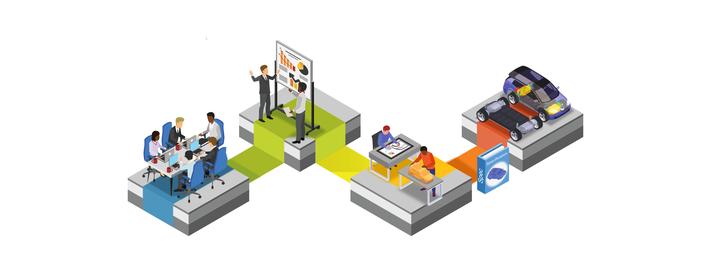
Overview
This course focuses on actions project Managers and Systems Engineers can take to initiate or improve the performance of their systems.
This course covers both ‘design for RM&A’ and ‘RM&A validation’ activities to provide the viewpoints of the system developer and the end user.
This course also covers the essential mathematical calculations that are essential to initiating, specifying and testing RM&A requirements, to and includes the application of how you can use RM&A calculations to estimate and improve your overall system's availability.
What Will You Gain by Taking This Course
- You will be able to have more informed conversations with RM&A Subject Matter Experts (SMEs) within your organization
- You will be able to define Reliability, Maintainability & Availability - and how they relate to each other
- You will understand the benefits and limitations of RM&A
- You will understand fundamental RM&A tools and techniques (see curriculum below)
- You will be able to identify and use foundational system reliability calculations
- You will gain knowledge and understanding of Failure Modes Effects and Criticality Analysis (FMECA) and other critical tools

Reliability
The Reliability Module covers foundational tools & principles such as reliability in the life cycle, reliability myths, reliability requirements, failures & failure modes, failure mode effects, failure rates, and key reliability distributions such as exponential, logarithmic, gaussian, and the Weibull distribution - as well as "the bathtub curve". This module also covers Mean Time Between Failures (MTBF) and Mean Time To Fail (MTTF) and other reliability measurements. Finally, this module covers extending service lives, determining reliability using networks, reliability allocation, FMEA & FMECA, and reliability prediction and growth.

Maintainability
The Maintainability Module covers the fundamental principles of maintainability. These include topics such as maintainability in the life cycle, maintainability requirements, Uptime (UT), Downtime (DT), preventive & corrective maintenance, Mean Time To Repair (MTTR), Level of Repair Analysis (LORA), Condition-Based Maintenance (CBM), the Potential to Functional Failure Curve, maintainability allocation, maintainability trade offs and maintainability allocations.

Availability
The Availability Module covers the fundamental principles of estimating, measuring and applying availability. This module also covers the three primary types of availability: Inherent Availability (Ai), Achieved Availability (Aa) and Operational Availability (Ao).
Example Curriculum
- Reliability Definition (7:18)
- Reliability in the Life Cycle (9:51)
- Reliability Myths (7:11)
- Reliability In Context (5:52)
- Relationship Between Reliability & Maintainability (2:42)
- What is a Failure? (8:46)
- Mission Reliability (2:39)
- Service Lives & Useful Lives (1:34)
- System Life Reliability (5:26)
- Failure Rates (λ) (2:14)
- Reliability Data Distributions (7:20)
- The Probability Density Function (PDF) (4:02)
- Exponential Distributions (5:34)
- Component Repair vs Replacement (11:40)
- The Gaussian Distribution (7:10)
- The Logarithmic-Normal Distribution (2:42)
- The Weibull Distribution (7:51)
- The Cumulative Distribution Function (CDF) (4:04)
- The Reliability Function (R) (9:32)
- Reliability Estimates (4:20)
- The Failure Rate Function (6:00)
- The Hazard Function (6:36)
- Introduction to MTBF & MTTF (1:04)
- Mean Time Between Failures (MTBF) (1:18)
- Mean Time To Failure (MTTF) (0:30)
- Calculating MTBF and MTTF (3:48)
- MTTF & MTBF Precautions (5:51)
- The Median Life Function (2:17)
- The Mode Life Function (3:05)
- The Decreasing Failures Region (DFR) (7:27)
- The Stabilized Failures Region (SFR) (3:47)
- The Increasing Failures Region (IFR) (7:19)
- Service Life Extension Programs (SLEP) (3:52)
- Storage and Shelf Life Factors (1:22)
- Misapplication of the Hazard Rate (2:25)
- Introduction to Reliability Networks (3:11)
- Series Networks (7:22)
- Parallel Networks (8:36)
- Series / Parallel Network Combinations (21:33)
- Reliability Allocations (7:58)
- Reliability Requirements (9:56)
- Stress & Strain Analysis (4:12)
- Failure Mode Effects Analysis (FMEA) (7:06)
- The FMEA & FMECA Process (7:41)
- Fault Trees (2:29)
- FMECA Reporting (6:36)
- Introduction to Maintainability (6:32)
- Maintainability in the Life Cycle (6:41)
- System Maintenance (9:08)
- Maintenance Levels & FRACAS (7:22)
- Uptime (UT) & Downtime (DT) (0:39)
- Mean Uptime (0:53)
- Mean Downtime, MLDT & MADT (7:41)
- Uptime / Downtime Ratio (1:01)
- Preventive Maintenance and PMT (6:20)
- Corrective Maintenance (18:59)
- Maintenance Labor Hours (1:58)
- Maintenance Frequency (1:50)
- Mean Time To Repair (MTTR) and Restore to Service (MTRS) (1:20)
- Mean Time Between Maintenance (MTBM) (1:13)
- Maintainability Analysis (0:47)
- Level of Readiness Analysis (LORA) (1:33)
- Reliability Centered Maintenance (RCM) (6:27)
- Condition Based Maintenance (CBM) (5:49)
- Potential to Functional (PF) Failure Ratio (3:22)
- Maintenance Cost Factors (1:21)
- Maintainability Predictions (4:47)
- Maintainability Requirements (3:52)
- Maintainability Allocation (12:36)
- Trade-Off Analysis: Reliability vs Maintainability (2:45)
- Reliability, Maintainability and Availability Challenges (5:25)
- Reliability Starting Values (2:45)
- RM&A in Design Reviews (4:14)
- Testing for Reliability (1:37)
- Testing for Maintainability (1:13)
- Reliability Sequential Testing (9:39)
- Reliability in Qualification and Life Testing (2:36)
- Course Closeout (2:59)
- Course Survey

Audience & Prerequisites
This introductory course is designed for:
- Project managers
- Systems Engineers
- Development team members
- Acquisition team members
- Hardware and software engineers
- Process engineers
- Maintenance professionals
- Logisticians
- Design engineers
- Reliability newcomers
- Product & program managers / executives
Prerequisites (preferred):
- Product Development & Systems Engineering course
- Algebra I & II
Suggested but not required:
- Calculus (Integral)
- Applied Statistics
- Trigonometry/Pre-Calculus
Other Products
As a pre-requisite and to supplement this course, feel free to check out this course.



